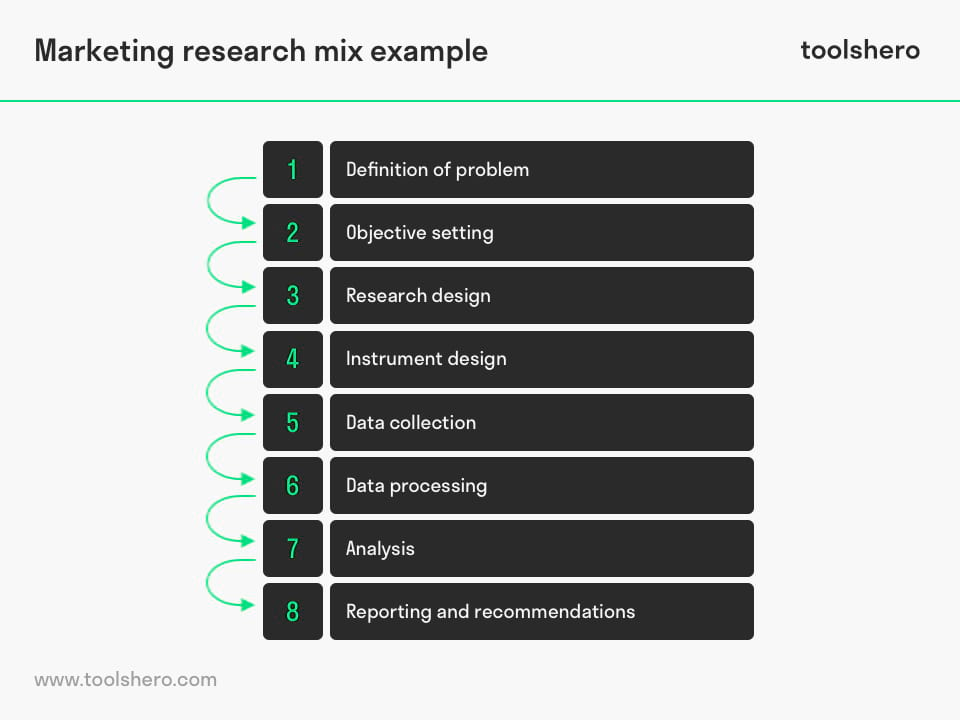Marketing Research Mix (MR Mix)

Marketing Research Mix: this article provides a practical explanation of the Marketing Research Mix. After reading it, you’ll have a better understanding of how to conduct market research.
What is a Marketing Research Mix?
The Marketing Research Mix or the ‘MR mix’ was made in 2004 and published in 2007 by Nigel Bradley. He’s a university professor of marketing at the University of Westminster in London.
This type of research was designed as a framework to help researchers design or evaluate marketing research studies. Like the marketing mix, the Marketing Research Mix also has four Ps. However, unlike the marketing mix, these elements are consecutive and belong to the most important phases that have to be observed. These four Ps are purpose, population, procedure, and publications.
Purpose refers to the goals. The term population encourages the researcher to consider the target audience, customer, or player.
Procedures refer to the means to record, process, and then analyse data. This can be desk research, or you can use primary methods. These can be qualitative or quantitative, as well as personal, by phone, by post, or even online. Publication refers to the communicating of results using written reports and verbal presentations.
Marketing research consists of four phases. One example of these is:
Bradley proposed four Ps and called these the marketing research mix. The four Ps help researchers to conduct market research. In his book, ‘Marketing Research: Tools & Techniques’ he expressly explains that the four Ps below must be used consistently and correspond to the most important phases of the research.
Why use the Marketing Research Mix?
By researching a potential or existing market, you can identify your consumer or understand which products would yield high profits for your business. You will find out which product your target market needs or wants, or who your potential customers are.
If your company is already in business, marketing research can be used to identify the limitations or shortcomings of your product(s) or your customers’ expectations. With marketing research, you can determine what the best price is for your product(s) or at what price you would make a profit. It can give you important information about your competitors, so you can set a fair and competitive price. You can also use the results of the research to reduce costs and increase your profit margin.
Investing in market research enables you to reach your target audience. You can promote your company or communicate more effectively and efficiently with your customers.
The Marketing Research Mix can offer you the solutions you need to face different challenges, such as:
- How trends affect the company;
- How to increase market share;
- How the customers or potential market make their purchase decisions;
- How does your customer service compare to that of the competition;
- How can you attract and land new customers;
- What is the best marketing strategy to reach the target audience and increase the company’s profitability.
Getting started with the Marketing Research Mix
Purpose: define the purpose of the Marketing Research Mix
The purpose of Marketing research mix is the reason why it’s being conducted.
The first step is to define the null hypothesis, abbreviated to H0. It’s usually meant to be rejected. Another carefully worded hypothesis is the alternative hypothesis or the H1; this is actually called the ‘research hypothesis’. When these are defined, the researcher can design a research programme to test the hypotheses.
When the results come in, they are compared to the null hypothesis’s prediction. The basic idea is to use this possible explanation and then look for data that support the explanation (or don’t).
It’s best to spend as much time as possible on the hypothesis: it’s the research question and determines how the research is conducted. It determines the topic because it defines the problem.
Population: determine the sample audience
When considering a market sector, you have to ask the following questions: Who is involved with this market? Who are the players? Who should be the focus of the research and where can they be found? This part looks at the target audience, customer, or player; the users or non-users. Who will be the respondent or informant? Should we contact all players or just a few?
An important concept for primary research is sample taking. That means the interviewing or observing of people of which you think they can provide you with the information that will solve your problems. Therefore, when deciding your research method, you have to consider who will be selected and how. In the case of qualitative research this can be a small group. You need a large group for quantitative research.
Procedure: decision about the methods to conduct the research
When determining the procedure, the key question is: How should the research be conducted? Will it be qualitative or quantitative? This part also covers the issue of timing; when will the field work be done?
The best studies start with looking at secondary data. The two main sources: internal (within an organisation) and external, published from a person outside the organisation. These have become more accessible in recent years.
When secondary data doesn’t resolve the problem, look for original data (primary data). It’s useful to think of different primary methods: we can ask people what they’re doing; we can observe them or find out what they have done by counting, or we can manipulate certain variables to discover the effect. This creates three categories: asking questions; observation and experimentation.
Primary techniques for data gathering can be divided into: interviewer administered or respondent administered; direct or indirect; personal or impersonal. Processing of the data, analysis, and interpretation are essential parts of the procedure. Detailed research should be done regarding suitable instruments that can be used for data gathering.
Publication: defines the requirements for how and when the research will be presented. The most important questions under the header ‘Publication’ are: Who is the audience for the results? What needs to be communicated? When and how does it need to be communicated? Research won’t be useful if findings are kept within the research team. At the same time, commercially sensitive information won’t give you a competitive edge if it’s shared publicly. Choices will have to be made about how to publish.
There are many different readers of research reports, and these target audiences all have very different expectations. Reporting must be personalised, writing and presentation style must be tailored to the user.
Now it’s your turn
What do you think? Do you recognise this explanation of the marketing research mix, or do you have anything to add? When do you think market research can be effective? What do you believe are success factors that contribute to the practical application of this theory?
Share your experience and knowledge in the comments box below.
More information
- Borden, N. H. (1964). The concept of the marketing mix. Journal of advertising research, 4(2), 2-7.
- Bradley, N. (2007). Marketing research: tools & techniques. Oxford University Press, USA.
- Hair, J. F., Celsi, M., Ortinau, D. J., & Bush, R. P. (2008). Essentials of marketing research. New York, NY: McGraw-Hill Higher Education.
- Zikmund, W., & Babin, B. (2006). Exploring marketing research. Cengage Learning.
How to cite this article:
Sari, J. (2020). Marketing Research Mix (MR Mix). Retrieved [insert date] from Toolshero: https://www.toolshero.com/marketing/marketing-research-mix/
Published on: 03/11/2020 | Last update: 03/25/2022
Add a link to this page on your website:
<a href=”https://www.toolshero.com/marketing/marketing-research-mix/”>Toolshero: Marketing Research Mix (MR Mix)</a>







